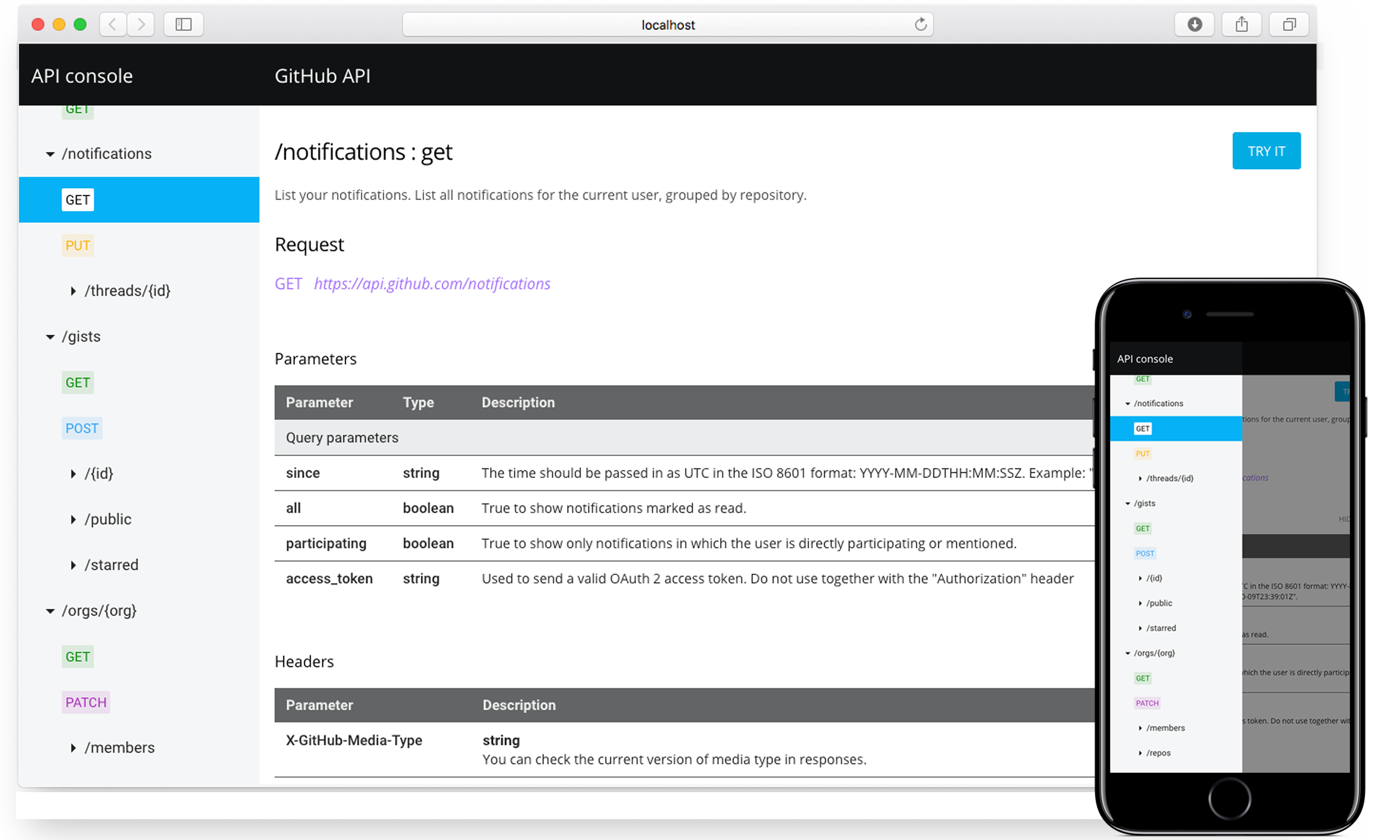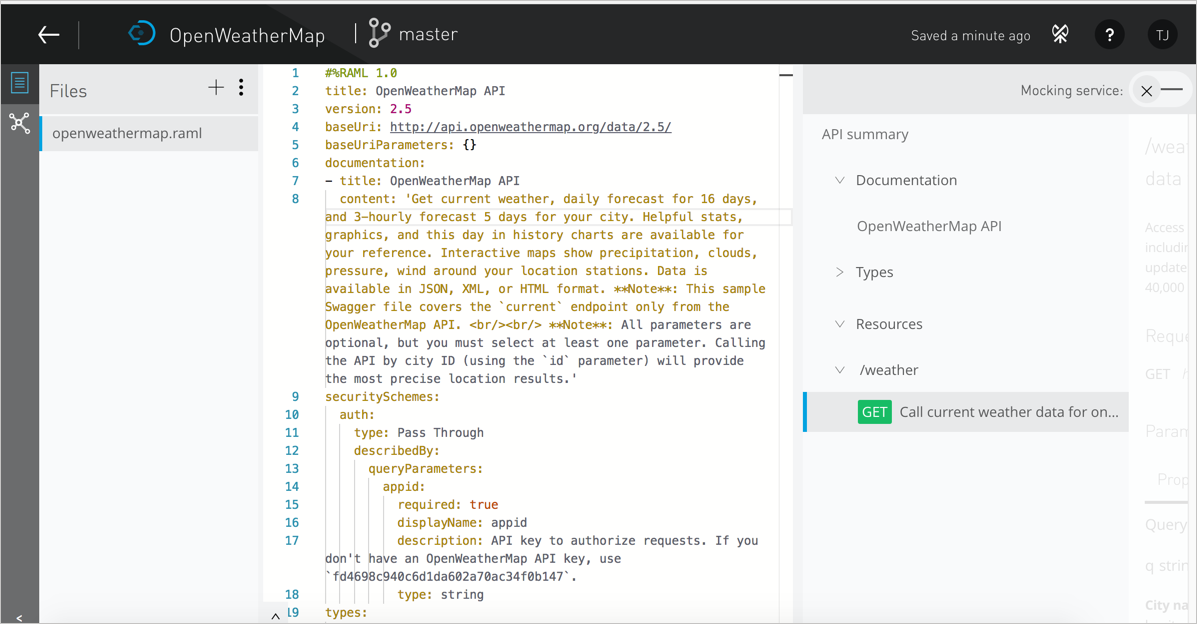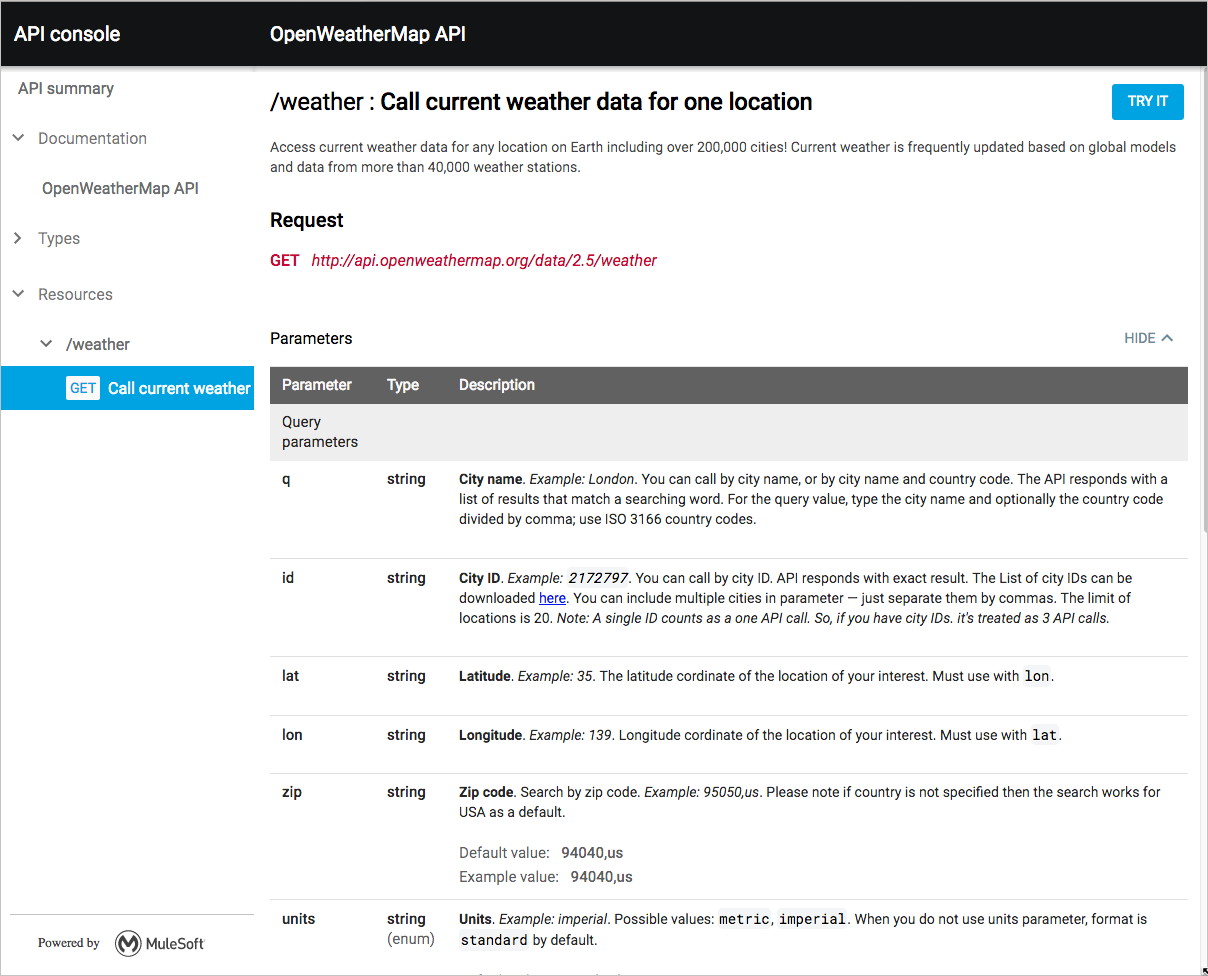RAML tutorial
RAML stands for REST API Modeling Language and is similar to the OpenAPI specification. RAML is backed by Mulesoft, a full-service, end-to-end API company.
Note that unless you’re publishing your docs with Mulesoft or another platform that specifically requires RAML, I recommend using the OpenAPI specification instead. However, Mulesoft offers enterprise-grade API design, management, and deployment capabilities. If you’re using Mulesoft for your API, you probably want to use RAML for your documentation specification.
- RAML overview
- Auto-generating client SDK code
- Sample spec for OpenWeatherMap API
- Outputs
- Developer Portal on Anypoint platform
- API Console output
- RAML2HTML project
- Conclusion
RAML overview
Similar to OpenAPI, after you create a RAML file that describes your API, it can be consumed by different platforms to parse and display the information in interactive outputs. The RAML format, which uses YML syntax, is human-readable, efficient, and simple. Here’s what the RAML output looks like in API Console (which is similar to Swagger UI):

You can see a demo with the Google Drive API.
Auto-generating client SDK code
It’s important to note that with these REST API specifications (as with the OpenAPI spec), you’re not just describing an API to generate a nifty doc output with an interactive console. There are tools that can also generate client SDKs and other code from the spec into a library that you can integrate into your project. These tools can make it easier for developers to make requests to your API and receive responses.
Additionally, the interactive console can provide a way to prototype and beta test your API before developers even start coding. Mulesoft offers a “mocking service” for your API that simulates calls and responses. The idea of the mocking service is to design your API the right way from the start, without iterating with different versions as you try to get the endpoints right.
Sample spec for OpenWeatherMap API
To understand the proper syntax and format for RAML, you need to read the RAML spec and look at some examples. See this RAML tutorial to get started.
Here’s the OpenWeatherMap API (which we’ve been using in this course) formatted in the RAML spec. (I actually just used API Transformer to convert my OpenAPI 3.0 spec to RAML.) As you can see, RAML is highly similar to the OpenAPI spec.
#%RAML 1.0
title: OpenWeatherMap API
version: 2.5
baseUri: https://mocksvc.mulesoft.com/mocks/082e051b-e960-48f7-9d75-2f49af8ccd86/data/2.5/ # baseUri: http://api.openweathermap.org/data/2.5/
baseUriParameters: {}
documentation:
- title: OpenWeatherMap API
content: 'Get the current weather, daily forecast for 16 days, and a three-hour-interval forecast for 5 days for your city. Helpful stats, graphics, and this day in history charts are available for your reference. Interactive maps show precipitation, clouds, pressure, wind around your location stations. Data is available in JSON, XML, or HTML format. **Note**: This sample Swagger file covers the `current` endpoint only from the OpenWeatherMap API. <br/><br/> **Note**: All parameters are optional, but you must select at least one parameter. Calling the API by city ID (using the `id` parameter) will provide the most precise location results.'
securitySchemes:
auth:
type: Pass Through
describedBy:
queryParameters:
appid:
required: true
displayName: appid
description: API key to authorize requests.
type: string
types:
SuccessfulResponse:
displayName: Successful response
type: object
properties:
coord:
required: false
displayName: coord
type: Coord
weather:
required: false
displayName: weather
description: (more info Weather condition codes)
type: array
items:
type: Weather
base:
required: false
displayName: base
description: Internal parameter
type: string
main:
required: false
displayName: main
type: Main
visibility:
required: false
displayName: visibility
description: Visibility, meter
type: integer
format: int32
wind:
required: false
displayName: wind
type: Wind
clouds:
required: false
displayName: clouds
type: Clouds
rain:
required: false
displayName: rain
type: Rain
snow:
required: false
displayName: snow
type: Snow
dt:
required: false
displayName: dt
description: Time of data calculation, unix, UTC
type: integer
format: int32
sys:
required: false
displayName: sys
type: Sys
id:
required: false
displayName: id
description: City ID
type: integer
format: int32
name:
required: false
displayName: name
type: string
cod:
required: false
displayName: cod
description: Internal parameter
type: integer
format: int32
Coord:
displayName: Coord
type: object
properties:
lon:
required: false
displayName: lon
description: City geo location, longitude
type: number
format: double
lat:
required: false
displayName: lat
description: City geo location, latitude
type: number
format: double
Weather:
displayName: Weather
type: object
properties:
id:
required: false
displayName: id
description: Weather condition id
type: integer
format: int32
main:
required: false
displayName: main
description: Group of weather parameters (Rain, Snow, Extreme etc.)
type: string
description:
required: false
displayName: description
description: Weather condition within the group
type: string
icon:
required: false
displayName: icon
description: Weather icon id
type: string
Main:
displayName: Main
type: object
properties:
temp:
required: false
displayName: temp
description: 'Temperature. Unit Default: Kelvin, Metric: Celsius, Imperial: Fahrenheit.'
type: number
format: double
pressure:
required: false
displayName: pressure
description: Atmospheric pressure (on the sea level, if there is no sea_level or grnd_level data), hPa
type: integer
format: int32
humidity:
required: false
displayName: humidity
description: Humidity, %
type: integer
format: int32
temp_min:
required: false
displayName: temp_min
description: 'Minimum temperature at the moment. This is deviation from current temp that is possible for large cities and megalopolises geographically expanded (use these parameter optionally). Unit Default: Kelvin, Metric: Celsius, Imperial: Fahrenheit.'
type: number
format: double
temp_max:
required: false
displayName: temp_max
description: 'Maximum temperature at the moment. This is deviation from current temp that is possible for large cities and megalopolises geographically expanded (use these parameter optionally). Unit Default: Kelvin, Metric: Celsius, Imperial: Fahrenheit.'
type: number
format: double
sea_level:
required: false
displayName: sea_level
description: Atmospheric pressure on the sea level, hPa
type: number
format: double
grnd_level:
required: false
displayName: grnd_level
description: Atmospheric pressure on the ground level, hPa
type: number
format: double
Wind:
displayName: Wind
type: object
properties:
speed:
required: false
displayName: speed
description: 'Wind speed. Unit Default: meter/sec, Metric: meter/sec, Imperial: miles/hour.'
type: number
format: double
deg:
required: false
displayName: deg
description: Wind direction, degrees (meteorological)
type: integer
format: int32
Clouds:
displayName: Clouds
type: object
properties:
all:
required: false
displayName: all
description: Cloudiness, %
type: integer
format: int32
Rain:
displayName: Rain
type: object
properties:
3h:
required: false
displayName: 3h
description: Rain volume for the last 3 hours
type: integer
format: int32
Snow:
displayName: Snow
type: object
properties:
3h:
required: false
displayName: 3h
description: Snow volume for the last 3 hours
type: number
format: double
Sys:
displayName: Sys
type: object
properties:
type:
required: false
displayName: type
description: Internal parameter
type: integer
format: int32
id:
required: false
displayName: id
description: Internal parameter
type: integer
format: int32
message:
required: false
displayName: message
description: Internal parameter
type: number
format: double
country:
required: false
displayName: country
description: Country code (GB, JP etc.)
type: string
sunrise:
required: false
displayName: sunrise
description: Sunrise time, unix, UTC
type: integer
format: int32
sunset:
required: false
displayName: sunset
description: Sunset time, unix, UTC
type: integer
format: int32
/weather:
get:
displayName: Call current weather data for one location
description: Access current weather data for any location on Earth including over 200,000 cities! Current weather is frequently updated based on global models and data from more than 40,000 weather stations.
securedBy:
- auth
queryParameters:
q:
required: false
displayName: q
description: '**City name**. *Example: London*. You can call by city name, or by city name and country code. The API responds with a list of results that match a searching word. For the query value, type the city name and optionally the country code divided by a comma; use ISO 3166 country codes.'
type: string
id:
required: false
displayName: id
description: "**City ID**. *Example: `2172797`*. You can call by city ID. The API responds with the exact result. The List of city IDs can be downloaded [here](http://bulk.openweathermap.org/sample/). You can include multiple cities in this parameter — just separate them by commas. The limit of locations is 20. *Note: A single ID counts as a one API call. So, if you have city IDs, it's treated as 3 API calls.*"
type: string
lat:
required: false
displayName: lat
description: '**Latitude**. *Example: 35*. The latitude coordinate of the location of your interest. Must use with `lon`.'
type: string
lon:
required: false
displayName: lon
description: '**Longitude**. *Example: 139*. Longitude coordinate of the location of your interest. Must use with `lat`.'
type: string
zip:
required: false
default: 94040,us
example: 94040,us
displayName: zip
description: '**Zip code**. Search by zip code. *Example: 95050,us*. Please note that if the country is not specified, the search uses USA as a default.'
type: string
units:
required: false
default: standard
example:
value: imperial
displayName: units
description: '**Units**. *Example: imperial*. Possible values: `metric`, `imperial`. When you do not use the `units` parameter, the format is `standard` by default.'
type: string
enum:
- standard
- metric
- imperial
lang:
required: false
default: en
example:
value: en
displayName: lang
description: '**Language**. *Example: en*. You can use lang parameter to get the output in your language. We support the following languages that you can use with the corresponded lang values: Arabic - `ar`, Bulgarian - `bg`, Catalan - `ca`, Czech - `cz`, German - `de`, Greek - `el`, English - `en`, Persian (Farsi) - `fa`, Finnish - `fi`, French - `fr`, Galician - `gl`, Croatian - `hr`, Hungarian - `hu`, Italian - `it`, Japanese - `ja`, Korean - `kr`, Latvian - `la`, Lithuanian - `lt`, Macedonian - `mk`, Dutch - `nl`, Polish - `pl`, Portuguese - `pt`, Romanian - `ro`, Russian - `ru`, Swedish - `se`, Slovak - `sk`, Slovenian - `sl`, Spanish - `es`, Turkish - `tr`, Ukrainian - `ua`, Vietnamese - `vi`, Chinese Simplified - `zh_cn`, Chinese Traditional - `zh_tw`.'
type: string
enum:
- ar
- bg
- ca
- cz
- de
- el
- en
- fa
- fi
- fr
- gl
- hr
- hu
- it
- ja
- kr
- la
- lt
- mk
- nl
- pl
- pt
- ro
- ru
- se
- sk
- sl
- es
- tr
- ua
- vi
- zh_cn
- zh_tw
Mode:
required: false
default: json
example:
value: json
displayName: Mode
description: '**Mode**. *Example: html*. Determines the format of the response. Possible values are `xml` and `html`. If the mode parameter is empty, the format is `json` by default.'
type: string
enum:
- json
- xml
- html
responses:
200:
description: Successful response
body:
application/json:
displayName: response
description: Successful response
type: SuccessfulResponse
404:
description: Not found response
body: {}
RAML’s specification format is highly similar to the OpenAPI spec. There’s really not much point in having multiple specifications for REST APIs in the industry, so my guess is that in five years, RAML will be obsolete.
Outputs
You can generate outputs using the RAML spec from a variety of platforms. Here are three ways:
- Developer Portal on Anypoint platform. Choose this option if you are developing and delivering your API on Mulesoft’s Anypoint platform.
- API Console output. Choose this option if you want a standalone API Console output delivered on your own server. (Note that this option also allows you to embed the console in an iframe.)
- RAML2HTML project. Choose this option if you want a simple HTML output of your API documentation. No interactive console is included.
More detail about each of these options is provided in the following sections.
Developer Portal on Anypoint platform
Anypoint is the API development platform on Mulesoft. APIs you develop with Mulesoft can be shared and viewed on their Anypoint Exchange portal.
The Anypoint console has a dashboard where you can work on your RAML definition, add other documentation pages (outside the spec), configure mocking services, and more. If your company already uses Mulesoft for other API development services, it would make sense to use their documentation and portal features as well. You can also export your RAML definition to OpenAPI through the Anypoint console.

Note that you can add additional pages to your documentation in Anypoint. (Kudos to the Mulesoft team for recognizing that API documentation is more than just a set of reference endpoints.)
Here’s what the sample OpenWeatherMap API looks like in Anypoint Exchange:

One of the unique options Mulesoft offers is called API Notebook. This is a unique tool designed by Mulesoft that allows you to provide interactive code examples that leverage your RAML spec.
API Console output
You can download the same code that generates the output on the Anypoint Platform and create your own interactive documentation. The standalone project (on GitHub) is called API Console. Here’s a demo. Instructions for building API Console from a RAML file are available on the api-console project on GitHub. After you build the output, upload it to a web server and go to the index.html file.
Here’s the OpenWeather API in API Console:

You can also embed the API console as an HTML element.
RAML2HTML project
Finally, you can also use a tool called RAML2HTML project to generate HTML documentation from a RAML spec. Here’s an example of what the RAML2HTML output looks like. It’s a static HTML output without any interactivity. See the RAML2HTML documentation for instructions on generating this output.
Conclusion
Exploring Mulesoft in more depth is beyond the scope of this tutorial, but hopefully I’ve introduced you to RAML and Mulesoft. Overall, large platforms that process and display your API documentation can only do so if your documentation aligns with a spec their tools can parse. RAML provides this standard spec for the Mulesoft ecosystem of tools. Their enterprise-level API tools provide powerful capabilities for your API.
139/145 pages complete. Only 6 more pages to go.
